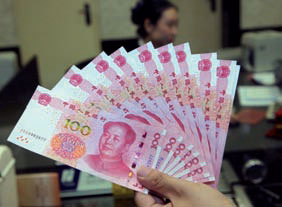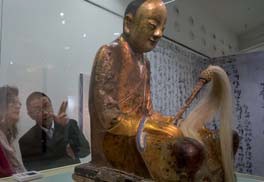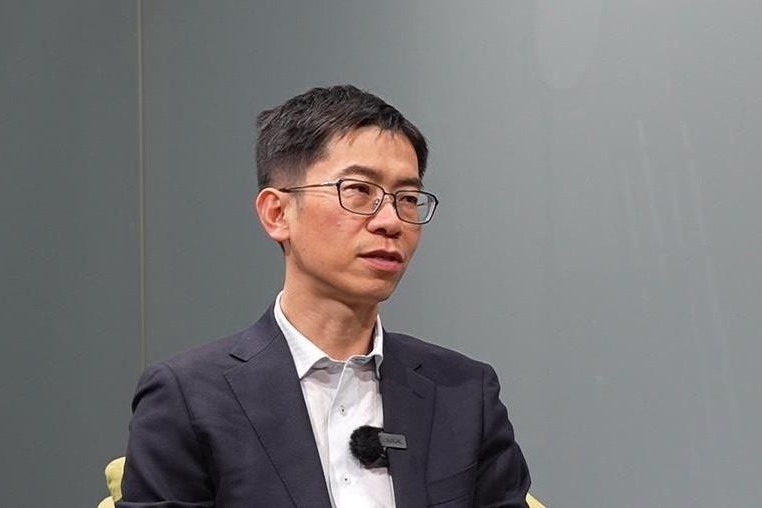IN BRIEF (Page 2)

| Visitors at the Temple of Heaven in Beijing. The number of tourist visits by people from outside the Chinese mainland rose 4.4 percent in the first nine months of the year. Jin Wen / For China Daily |
Inbound tourism falling short of goal
The number of overseas tourists in China has fallen over the past three years and is unlikely to meet the goal set by the 12th Five-Year Plan (2011-15), industry insiders have warned.
The plan calls for the number of foreign tourists to rise 4.5 percent a year and the number of overseas tourists to rise 3 percent a year. (The term foreign tourists means visitors other than from the Chinese mainland and Hong Kong, Macao and Taiwan; the term overseas tourists means visitors from anywhere outside the mainland.)
To meet the targets, 31.1 million foreign tourists and 153 million overseas tourists will need to have come to China by the end of the year.
In the first nine months of this year, visits by foreign tourists fell 1.1 percent compared with the corresponding period last year to 19 million, and the number of overseas tourists rose 4.4 percent to 99 million.
Li welcomes nuclear teamwork with US
Premier Li Keqiang said China supports joint research with the United States on nuclear power projects to integrate China's industrial capacity with overseas advanced energy technologies.
He made the remarks while meeting with Microsoft founder Bill Gates, who is chairman of Terra Power, a nuclear energy technology company based in Bellevue, Washington.
Li said the Chinese government encourages combining domestic industrial capacity and advanced technologies and design from the US. Safety, low cost and sustainability are the keys to such an effort, he said.
"China is taking a greener, more sustainable path, during which we welcome cooperation on clean energy development and to fight against climate change," Li said.
Gates was in Beijing to promote the design of a traveling wave reactor, a new nuclear design using fourth-generation technology.
China to seek growth advice from foreigners
China's top economic regulator is seeking advice from overseas experts on the country's new five-year development plan.
The National Development and Reform Commission wants the advice to guide annual growth of no less than 6.5 percent.
Such advice from abroad is important to improving the 13th Five-Year Plan (2016-20), especially as the country's opening-up is deepening, said Hu Zucai, deputy head of the commission.
Various channels will be opened for foreigners to offer their advice from now until January, Hu said, including columns in various media and seminars with foreign chambers of commerce.
Central bank issues new 100-yuan bill

China's central bank, which issued a new 100-yuan bill on Nov 12, has been transporting increasing quantities of renminbi to foreign countries via Hong Kong to meet a growing demand for the currency.
The People's Bank of China transported 50 billion yuan ($7.83 billion; 7.36 billion euros) in cash to Hong Kong, the country's offshore renminbi center, during the first nine months of this year, an increase of more than 46 percent year-on-year, said Zhang Jianjun, director of the central bank's sub-central branch in Shenzhen, Guangdong province.
Threats to biodiversity spelled out in report
A report by the World Wild Fund for Nature has sounded a warning on the state of China's biodiversity - the different types of species found in the country and variations within them.
An official of the fund says habitat loss and degradation of nature caused by humans and development are the most significant threats to the country's biodiversity.
The report found that just two regions, Qinghai province and the Tibet autonomous region, have a so-called ecological surplus.
This means their regional biocapacity exceeds their ecological impact, which means regional biocapacity can meet the consumption demands of the local population.
The biocapacity of an ecosystem is an estimate of its production of certain biological materials such as natural resources, and its absorption and filtering of other materials such as carbon dioxide from the atmosphere.
Cities to hit targets for pollution cuts by 2017
China's major cities should reach their targets in reducing major air pollutants by 2017 as planned, experts say, though ozone poses a more stubborn problem.
Among the six major air pollutants listed in the Action Plan on Air Pollution Control and Prevention, the concentrations of five saw significant decreases in 2014 in 74 major cities, according to the Ministry of Environmental Protection.
For example, PM2.5, a fine particle that poses health hazards, fell 11.1 percent per cubic meter in 2014, while the concentration of sulfur dioxide was reduced by 20 percent year-on-year. Levels of nitrogen dioxide, carbon monoxide and PM10 also decreased.
However, a rising level of ozone may require the country to take more comprehensive measures, experts warned. Excessive ozone concentrations at ground level are generated mainly through complicated photochemical reactions. They have a close relationship with many other air pollutants, such as volatile organic compounds and nitrogen oxides.
Markets relocated to reduce traffic jams
Beijing has moved thousands of wholesale booths and shut down 315 polluting factories in the first three quarters of this year.
The move is designed to ease traffic congestion, support the development of less congested areas in the Beijing-Tianjin-Hebei cluster and reduce air pollution, local authorities said.
Wholesale markets draw thousands of retailers from all over the country that contribute to traffic jams in Beijing, especially during rush hours.
Tougher rules proposed for delivery companies
The central government is coming up with stricter rules to regulate the delivery industry, whose astonishing growth in recent years has largely been propelled by the growth in Chinese e-commerce.
Under the draft issued on Nov 16, Chinese courier companies face fines of up to 50,000 yuan ($7,830; 7,360 euros) and loss of licenses for divulging customers' personal information.
The draft also addresses the rough handling of parcels, which has led to a number of customer complaints.
Couriers who toss or step on parcels, or otherwise mishandle packages in a way that causes damage, could face fines up to 50,000 yuan as well as suspension of company operations.
Policy puts pressure on sperm banks
China's sperm banks are already facing a shortage of donors, and a government proposal to end the country's decades-old family planning policy may put more pressure on the institutions.
According to a report carried by Jiangxi Daily, a growing number of couples with fertility problems have visited local hospitals and sperm banks for consultations since the policy announcement in October.
The infertility rate is high in China, with statistics released by the China Population Association at the end of 2012 showing 40 million people have fertility issues, accounting for 12.5 percent of the population aged between 20 and 49. Many couples have turned to sperm banks for help.
Sperm banks are dealing with a worsening shortage of healthy sperm, despite repeated efforts to recruit more donors. The sole sperm bank in Jiangxi, launched in 2013, has only received about 1,400 sperm donors who meet the criteria required out of more than 6,000 volunteers.
Buddha statue dispute sent to Dutch court

One of the lawyers representing a village in Fujian province in its quest to win custody of a 1,000-year-old Buddha statue they say was stolen in 1995 said an appeal would be submitted to a court in the Netherlands later this month.
The statue contains the remains of a mummified monk.
"We have finished the primary investigation and collection of evidence in Yangchun, Fujian province, in preparation for an appeal to the court in the Netherlands later this month," said Liu Yang, a Beijing lawyer specializing in ancient relics.
One key hurdle is proving that the statue is the same one that was stolen, Liu said.
The lawyers, seven from China and the Netherlands, are seeking to reclaim the Buddha statue from its Dutch owner, architect Oscar van Overeem.
Pig gene technology promises big benefits
Chinese scientists have successfully modified a gene in pigs that enables the pigs to produce human serum albumin, a protein made by the liver.
The breakthrough was published recently by Scientific Reports, an online open-access journal from the publishers of Nature.
The scientists used a precise genome modification tool called CRISPR/Cas9 to insert a human albumin coding sequence into the pig gene.
Human serum albumin plays a critical role in keeping people healthy. It is used to treat a number of conditions, including liver diseases and traumatic shock.
Movie to contain anti-graft message
A movie based on a corruption case in the 1950s has entered production as China seeks to raise awareness of corruption amid a sweeping anti-graft campaign. The movie is based on the story of Liu Qingshan and Zhang Zishan, two senior Party officials who were among the country's earliest examples of modern corruption. Both were executed in 1952. Movie director Shen Yue said he hopes the 2016 film can serve as a warning to members of the Communist Party of China.
Portraits in tomb may include Confucius' image
Chinese archaeologists claimed to have unearthed a portrait of Confucius from a tomb that is at least 2,000 years old.
After they pieced together a broken lacquer screen found in the main chamber of the tomb, the archaeologists said, they restored two portraits, one of which is believed to be of Confucius.
"The Chinese characters on the screen include the names of Confucius; his father, Shu Lianghe; and one of his favorite disciples, Yan Hui," said Zhang Zhongli, deputy chief of the excavation team in Jiangxi province. He said the text on the screen was probably a brief biography of Confucius, but further evidence is needed to support the hypothesis, he said.
Many seniors have poor diet, survey finds
A survey of 3,885 elderly people across six provinces showed high rates of seniors who are overweight or malnourished, the China Development Research Foundation said on Nov 15. According to the survey, 31.8 percent of the respondents were overweight and 11.4 percent qualified as obese. The rate of malnutrition is also still high among low-income households, the single and widowed, and the elderly. About 12.5 percent of the respondents suffered from anemia.
(China Daily European Weekly 11/20/2015 page2)
Today's Top News
- Japan tempting fate if it interferes in the situation of Taiwan Strait
- Stable trade ties benefit China, US
- Experts advocate increasing scope of BRI to include soft power sectors
- New engine powers cargo drone expansion
- China to boost green industry cooperation
- Manufacturing PMI rises in November































